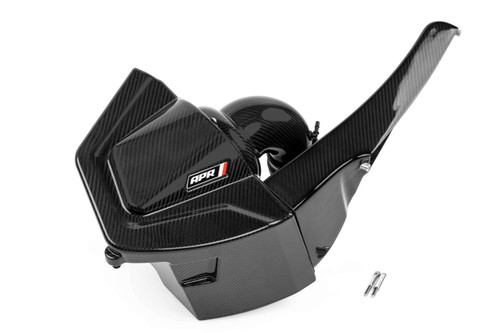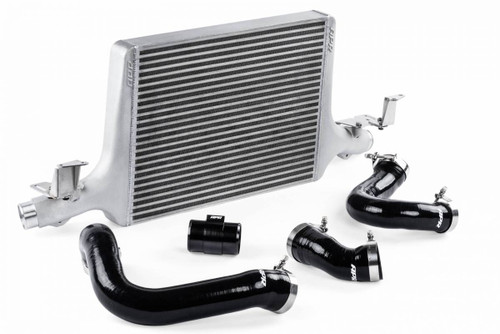 WARNING: This product can expose you to chemicals that are known to the State of California to cause cancer, birth defects or other reproductive harm. For more information, visit www.P65warnings.ca.gov.
WARNING: This product can expose you to chemicals that are known to the State of California to cause cancer, birth defects or other reproductive harm. For more information, visit www.P65warnings.ca.gov.The APR Front Mount Intercooler System (IC100022) is a massive front-mounted hardware upgrade that dramatically enhances performance on the Audi A4/A5 (B9) platform. This system drastically reduces Intake Air Temperature (IAT), minimizes power-robbing heat soak, and is a recommended upgrade for every stage of performance.
The intercooler features a highly effective bar-and-plate core design with a massive frontal surface area and core volume that is significantly larger than the OEM unit. This design was rigorously tested to optimize fin density and size, ensuring a low pressure drop combined with highly effective cooling. The smooth, organically shaped cast end tanks promote airflow across the entire core, and the included multi-ply silicone hoses and stainless-steel Clampco T-bolt clamps ensure a boost-leak-free, secure installation. This system is capable of retaining as high as 45 AWHP compared to the heat-soaked factory system.
Features:
-
Massive Performance Gain: Dramatically lowers IAT, increases HP, and minimizes heat soak, retaining up to 45 AWHP compared to the factory system.
-
Superior Core Design: Features a highly effective bar-and-plate core with staggered and louvered fins for optimal cooling and low pressure drop.
-
Increased Size: Massive increase in cooling capacity with 356.4 in² frontal surface area and 801.90 in³ core volume (significantly larger than stock: 162.4 in² / 507.62 in³).
-
Optimized Airflow: Includes smooth, organically shaped cast end tanks engineered for low turbulence and maximum flow across the entire core.
-
High-Quality Connections: Utilizes multi-ply silicone inlet/outlet hoses with internal wire reinforcement, fluorosilicone lining, and stainless-steel Clampco T-bolt clamps for leak prevention.
-
Ease of Installation: Simple bolt-on install with no trimming or drilling necessary, includes a precision CNC-machined billet MAP housing for secured sensor placement.
Product Contains:
-
(1) APR Bar-and-Plate Intercooler Core Assembly
-
(2) Smooth Cast End Tanks
-
(2) Multi-ply Silicone Inlet and Outlet Hoses (with Internal Wire Reinforcement)
-
(1) Precision CNC-Machined Billet MAP Housing
-
(1) Set of Stainless-Steel Clampco T-bolt Clamps
-
(1) Complete Bolt-on Installation Hardware Kit
Important Note: This is a massive front mounted upgrade that is highly recommended at every stage of performance modification to ensure consistent power output.
Warranty This product is supported by a Manufacturer's Warranty. Note: Manufacturer warranty terms are subject to change.
- PDP tag:
- Free Shipping*
- Sales:
- On Sale
- PDP tag:
- On Sale

















